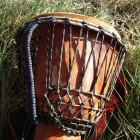![]() video step-by-step instructions
video step-by-step instructions
![]() how to rehead your djembe with weatherproof mylar
how to rehead your djembe with weatherproof mylar
Unless you have tightening bolts, like a conga, your djembe head will be strung with nylon cord. One of the most frequently asked questions about djembes is, “How do I tighten the skin on the head?”
A djembe that is poorly tuned doesn’t sound very good. The bass is deep but boomy; the slaps dull; the tones uninspiring. On the other hand, a drum head that is tuned too tight and high-pitched may be more than is needed in the situation. Ideally the highest-pitched djembe in a group will be the one playing lead and solo parts, to mark the changes in the dance. The higher pitch and sharper slaps will help the calls and breaks carry over the other drums and will be easier for the dancers to hear.
3 Keys to Tuning a Djembe
1. Be careful not to tighten your djembe head too much all at once, or you risk stretching it too thin and risking a tear. Especially be wary of changes in temperature and humidity, as a tight djembe head in a hot car or in desert conditions could blow out as it dries and shrinks. Also beware of tightening it too much if it’s still damp after re-heading. It’s better to wait until it’s perfectly dry before the final tightening and tuning. When you need a tuneup, try adding just 2-3 knots at a time and testing the results.
2. Before tuning with extra knots (known as the “Mali weave“) on a new drum head, make sure the vertical lengths of cord are stretched as taut as possible; a pair of vice grips can help by holding each loop steady at the top ring as you pull. It also helps to add leverage with a tool that can be as simple as a stout drumstick or hammer handle, for looping and pulling down on each vertical as you tighten it.
How to tighten the horizontal knots using the Mali Weave:
3. After tuning with the horizontal knots, you can fine-tune by tapping down on the rings (to seat the head more snugly) at various points around the head. For this a good tool to use is a rubber-headed mallet available from automotive supplies.
You will be surprised how much better your drumming can sound when you have a well-tuned djembe head! Just be sensible about it; trust your intuition about how much is enough; and take care not to have all the djembes in your group tuned at the same or similar high pitch. The polyrhythms of the various accompaniment parts in traditional West African rhythms are best heard on djembes with varying pitches, just as with the dununs (kenkeni, sangban, and dununba).
video step-by-step instructions for the horizontal knots
how to rehead your djembe with weatherproof mylar
comment: Excellent! I went form having no clue, to having a tightened and tuned djembe in minutes! Thank-you!
